[ad_1]
Buckingham Palace’s picture gallery contains some of the greatest paintings of western civilisation: 16th-century Titians, 17th-century Rembrandts, as well as works by Rubens and Van Dyck, and that rare thing, a Vermeer. Also on display are some of the most spectacular Canaletto vistas of 18th-century Venice.
It is a fine collection to have on the walls if you are member of the royal family. But access is far more limited for the public.
Outside the brief summer season during which it is officially open to the public, an “exclusive guided tour” of the palace provides visitors with about 5-10 minutes in the gallery itself to enjoy the paintings. The cost of a ticket is £90.
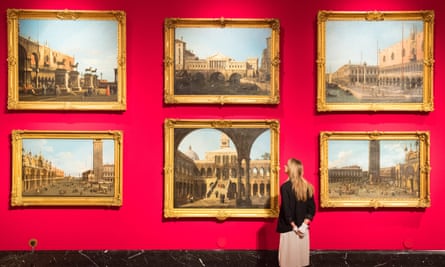
The accession of King Charles throws a new spotlight on the royal collection.
Acquired by monarchs over generations, it is the last of the European royal art treasure troves to remain more or less intact in the hands of a sovereign. Similar collections in France, Spain, Austria, the Netherlands, Sweden and Denmark have been largely ceded to state ownership and to palaces open to the public, or to more freely accessible national museums, either by revolution or by mutual agreement.
Charles III is known for his love of the arts. He has now become owner of the royal collection as king, but not as a private individual. The Windsor family does own a valuable private collection of art, composed in part of pieces that were bought by the Queen Mother or Prince Philip. But the royal collection is “held in trust by The King in right of the Crown for his Successors and the Nation” – or so the Royal Collection Trust (RCT), the charitable body set up in 1993 to manage it, says with a liberal sprinkling of Royal Capital Letters on its website.
We do not yet know what Charles’s promise of a slimmed-down modern monarchy will mean for the royal artworks. The director of the collection, who is appointed as a senior member of the royal household, declined to give an interview. But important questions remain about its status.
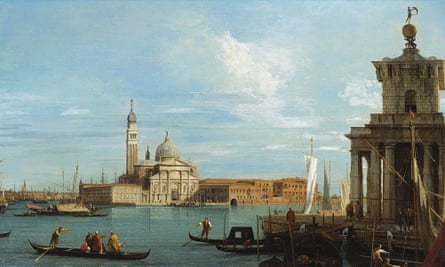
According to the RCT website, the collection comprises more than 1m works, ranging from paintings and sculpture to furniture, carpets, china and ornaments. Only about a quarter of that number, roughly 280,000, are so far catalogued in the RCT’s online database – the trust said that it had given priority to the most significant artworks in developing the catalogue. Of the quarter that are catalogued, just 4% (10,407) are entered with a location tag that enables the public to find out where they may be seen.
The royal collection contains a vast range of works of varying interest. Leaving aside the pen wipers, branding irons and bonbon dishes listed in the database, the Guardian has analysed the status, whereabouts and accessibility of the indisputable masterpieces of painting that the collection contains.
Just a quarter of the 5,641 paintings it has are given a location tag, meaning they are on show to the public. And many of those that are tagged are in palaces or residences that are open only for a short time each year.
Jerry Brotton, a historian and author of a book about the chequered history of the royal collection called The Sale of the Late King’s Goods: Charles I and his Art Collection, argues that the public should have much greater access to what is in effect national art. “The royal collection is not ‘heritage’, it’s art. If you treat it as heritage and an adjunct of royalty, it is reduced to a bibelot, a load of trinkets. We don’t even know where a lot of the stuff is.”
Tracking down the treasures
It takes a bit of detective work to find the RCT’s untagged treasures. For example, the royal collection includes the world’s largest and finest holding of work by Canaletto. Famous for their brilliant evocations of light and space, and for shifting perspectives that improved the view, Canaletto’s paintings of Venice were the ultimate picture-postcard souvenir for wealthy British aristocratic travellers on their Grand Tour of European culture in the 1700s. George III bought 52 of Canaletto’s best oils and a significant body of his drawings in 1762.
Of the 52 paintings by Canaletto listed in the RCT catalogue, only 24 are at identified locations: 12 luminous views of the Grand Canal are in a small room down a corridor off the Cumberland Gallery in Hampton Court Palace (adult entry fee £26.10), and another 12 are in Buckingham Palace (£90, or £30 in August and September), although not all of those are in the visitable picture gallery. Others are in rooms closed to the general public. The whereabouts of 28 other great paintings by the Venetian master are not revealed in the online catalogue.
However, the Guardian has managed to track down one. It is rare to get a glimpse inside the royals’ private residences but a promotional photograph taken during a BBC 5 interview revealed that one of these Canalettos has been enjoyed by Edward and Sophie, now Duke and Duchess of Edinburgh, in the drawing room of their private Bagshot Park home.
Quick GuideWhat is Cost of the crown?
Show
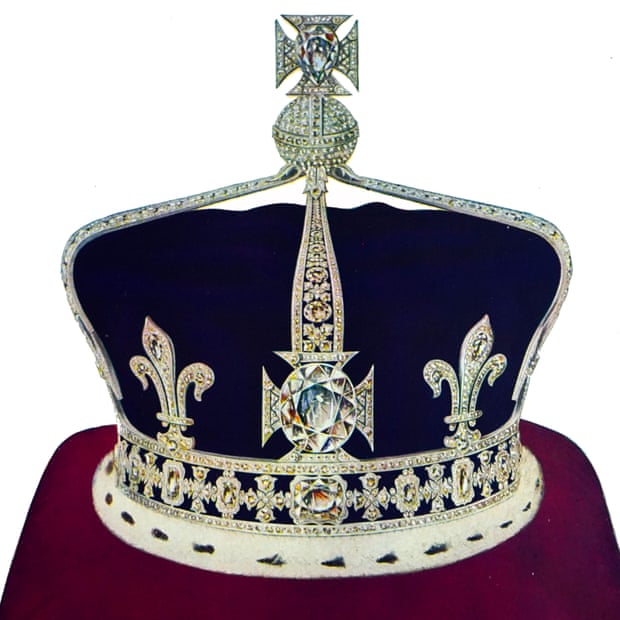
Cost of the crown is an investigation into royal wealth and finances. The series, published ahead of the coronation of King Charles III, is seeking to overcome centuries of secrecy to better understand how the royal family is funded, the extent to which individual members have profited from their public roles, and the dubious origins of some of their wealth. The Guardian believes it is in the public interest to clarify what can legitimately be called private wealth, what belongs to the British people, and what, as so often is the case, straddles the two.
• Read more about the investigation
• Fund Guardian investigative journalism that uncovers the secrets of the powerful that we all need to know
An exhibition mounted at Buckingham Palace to mark Charles’s 70th birthday in 2018 revealed that one his favourite paintings in the royal collection was a breathtaking work by Johan Zoffany that took six years to complete between 1772 and 1777. The Tribuna of the Uffizi is a tour-de-force representation of the domed gallery of that name in the Uffizi museum in Florence. In it, Zoffany reproduced dozens of famous paintings and classical sculptures in the style of their master creators through the ages.
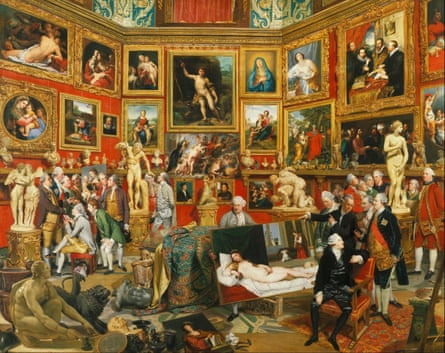
The painting has made appearances in exhibitions in 2009 and 2016 and, given its significance, might be expected to be on permanent public view. But the RCT catalogue is silent on the Tribuna’s whereabouts and the trust declined to say where it was. The Guardian understands it is in the Grand Corridor at Windsor Castle, where the king can enjoy it in his private quarters.
With such a surfeit of masterpieces, it is perhaps no surprise that some should hang in private apartments. Robin Simon, an art historian and editor of The British Art Journal, says the question of who has what, and which pieces the public should be permitted to see, is “deliberately very murky”. “A clear distinction was never made between privately owned works and the royal collection … It definitely happens that a royal would like a particular picture and it would go into private rooms to be enjoyed personally. And why not?”
One answer to that “why not” question came in the form of a controversy that erupted in 2016, when the then Duke and Duchess of Cambridge, William and Catherine, hosted the Obamas in the drawing room of their newly refurbished Kensington Palace apartment.
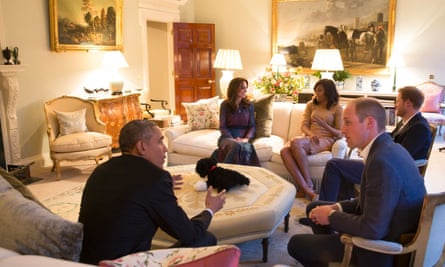
The couple had a valuable work by Marco Ricci, a Canaletto contemporary, adorning one wall. Dominating the room on another wall was a vast equestrian landscape from the royal collection by the 17th Dutch master Aelbert Cuyp, featuring a young black boy holding two noblemen’s horses. The painting is known as “the Negro page” from the label in its gilt frame; a pot plant was said to have been placed judiciously in front of the description, but the couple’s choice led to accusations of racial insensitivity. A spokesperson for the palace said the painting had been removed from the apartment several years ago, but declined to say where it was now.
Prince Andrew, although no longer a working royal, also appears to have had the benefit of various royal collection works, including a 19th-century oil portrait of Eugenie, Empress of the French and wife of Napoleon III, by Édouard Boutibonne, which has hung in his Royal Lodge residence. Andrew himself advertised for a maid in 2011 who, for £16,000 a year, would be expected to make beds and draw baths in the lodge, while also dusting “objets d’art” and looking after “picture frames under advice from the royal collection”.
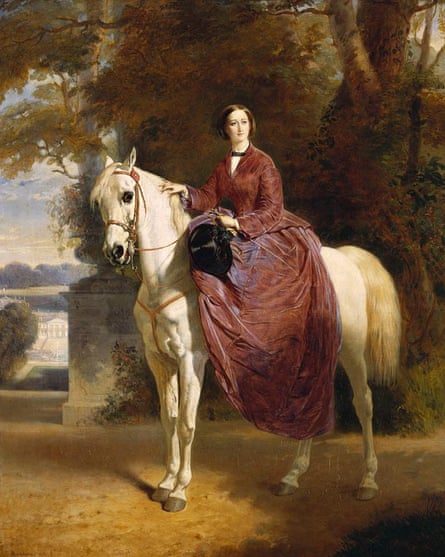
It has been reported that the king is considering opening Buckingham Palace for much longer periods to increase access and revenue. Opening it to the paying public for the first time was driven by a need to raise £40m to restore Windsor Castle after a devastating fire in 1992. This royal fundraiser, managed by the RCT, brought in £16.45m in the financial year 2018-19, before Covid closures drove the trust into deficit.
The paying public may have contributed millions of pounds towards the maintenance of the royal inheritance, but resources still appear to be inadequate . One of the most important series of paintings in the royal collection has been out of view for years thanks to a leaky roof.
A ‘dead’ collection?
The series of giant canvases by Andrea Mantegna, which have been described by experts as “the greatest masterpieces of the Italian Renaissance outside Italy” and a “landmark in western art”, were acquired by Charles I, the first great British connoisseur monarch.
Mantegna painted the Triumphs of Caesar series between 1485 and 1506, depicting imagined scenes from the Roman emperor’s triumphal processions. The Mantegnas were taken to Hampton Court Palace by Charles I and have remained there since.
They were housed in recent years in a gallery created in the Orangery, which had to be closed in 2020 and whose roof is leaking. It is not expected to reopen before 2026. Luckily the paintings were not damaged. Historic Royal Palaces, the charity that runs the unoccupied royal palaces, depends on admissions for most of its funding. “We lost most of our income with Covid, so we have to phase expenditure,” a spokesperson explained. It took HRP 12 years to repair the roof in another part of the Tudor palace.
The RCT is sensitive to criticism that the public has too little access to the collection and has put emphasis on increasing educational and loan programmes in recent years.
After the Guardian’s inquiries about the Mantegnas, the RCT said last week that the king had just agreed to lend six of the nine paintings in the series to the National Gallery to exhibit for a period from this autumn, although the details were still being discussed. Two others in the series have just been put back on show in a new location in Hampton Court and one is with RCT conservators.
Loans are also made from the print room at Windsor Castle, which is home to the royal collection of prints and drawings, including the world’s most important grouping of Leonardo drawings. The room is not open to the public – the 600 priceless Leonardos, along with hundreds of Holbeins, Hogarths, Canalettos and more, have to be kept in an atmosphere-controlled environment to preserve them – but the trust team host student visits, and are expanding the digital catalogue. They also manage the frequent dispatch of fragile works for external exhibitions.
Martin Clayton, the RCT’s head of prints and drawings, is the leading authority on Leonardo drawings. It would be “irresponsible” to have them on permanent public display, he said, because they would rapidly deteriorate. Instead selected works are lent in rotation to major exhibitions and in manageable groups of 10-12 to galleries around the UK, where they had attracted huge audiences and often served to “revitalise local arts venues”, Clayton added.
A spokesperson for The RCT said: “The aims of the trust are the care and conservation of the royal collection, and the promotion of access and enjoyment through exhibitions, publications, short- and long-term loans, educational programmes and digital initiatives.” Funding of its work comes from admissions and sales rather than government and the collection is a living and working one, “spread among some 15 royal residences and former residences across the UK, most of which are regularly open to the public”, the spokesperson added.
For Brotton, the historian, the effect of the collection being held by the sovereign rather than the nation is the opposite, however. He argues that it has become a “dead” collection. “There’s precious little serious new acquisition and no showing of the collection’s art in context, so that the public and art critics can evaluate it, and debate its merits and significance against other art movements in the way that new exhibitions elsewhere shed new light on key artists.” He would like to see Charles III follow the example of Prince Albert, Queen Victoria’s consort, who gave priceless Raphael cartoons for tapestries to the V&A museum on permanent loan for the public to see.
[ad_2]
#masterpieces #royal #palaces #sight #British #public
( With inputs from : www.theguardian.com )

Leave a Reply